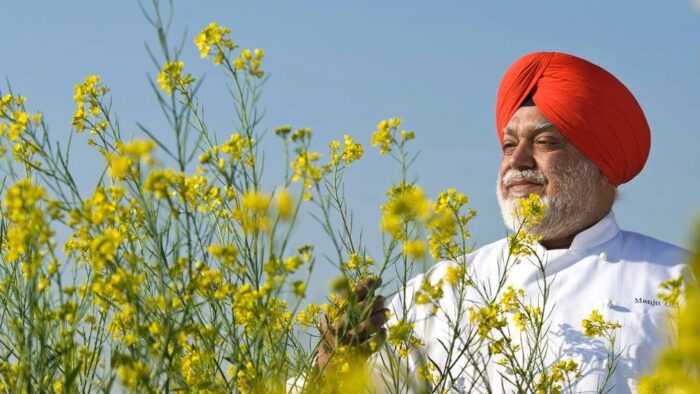Chef Manjit Singh Gill is legendary for his gastronomic innovation. As Corporate Chef, ITC Hotels, he has curated menus for the popular concept restaurants Bukhara (North West Frontier Cuisine), Dumpukht (Awadh), Dakshin (South Indian Cuisine) and Kebabs and Kurries (from across India) and the latest of all - Royal Vega ('Honestly' Vegetarian menu based on the ancient Indian system of seasonal cooking.) He has served several Presidents of different countries, and has pioneered many initiatives to promote Indian food. His passion for vegetarian food manifests in his continuous endeavour to explore, discover and research on Indian traditional cooking, and bring recognition to Indian philosophy of food based on wellness and sustainability. He holds several awards, and recognitions and continues to inspire as President, IFCA (Indian Federation of Culinary Associations).
Chef Manjit Singh Gill shares, "I believe that you need not be rich to create sumptuous food. It is not about money. It is about the skill to create soulful food."
Excerpts from an Interview with Chef Manjit Singh Gill, a visionary, who represented India at many international culinary events, authored books on Indian Gastronomy and Eating Well, and is passionately working towards discovering forgotten recipes of Indian cuisines.

How did a chef who worked on Bukhara and Dumpukht that were so much about non vegetarian food become so invested in Vegetarian food?
I am a vegetarian by choice. My sisters were studying in a Jain school and one day we decided meat will not be cooked at home. I have tasted meat for the first time only after joining hotel management. I do not mind tasting meat as a chef, and while doing that I can eat quite a lot; but my meals are always vegetarian. Even after working for many restaurants, what always bothered me was that the vegetarian eaters are not always happy to see a lot of meat around on buffets or even at an alacarte set up. Even the menu displays the non-vegetarian section first. And, there is hardly any choice on the vegetarian side. There are atleast 10 - 12 dishes made of paneer. Unlike what non-vegetarians think, vegetarians are not so fond of paneer. They would rather eat dishes made with fresh locally sourced vegetables.
Vegetarian food is much more balanced, more alkaline, and according to me it has more variety, that gets better with each season. It dramatically changes with season, and brings much more satisfaction when you eat food. I am talking about eating vegetarian food. Indian philosophy of vegetarian where dairy is also added.
Vegetarian menu is a combination of different elements like protein, carbs, fibre and fat and supplies ot body's desire for balanced food.

How was the experience of creating the all-vegetarian menu for ITC's Royal Vega ?
Vegetarian food is available in every restaurant, but it is made in the same kitchen using same spices, and by the chefs who cook both vegetarian and non-vegetarian. When I got the opportunity to work for a vegetarian restaurant, it was easy for me to understand the sensibilities of vegetarian food. However, I realized that it was not that easy to create the menu. I took three years. For vegetarian dishes the quality of ingredients is very important. This is true even for meat dishes, but the quality of meat covers up for the other condiments. Whereas for cooking vegetarian food one cannot compromise. We realized that we cannot work well without making specifications of spices, which was never made before this. For every vegetable there is a different mix of spices that has to be used.
Vegetarian cooking is closer to sea food cooking. Also at the restaurant we call our food honest, and not just pure. We can cook pure food like we do in Bukhara where there is even a separate tandoor used for vegetarian; it is still subjective. Honesty is not subjective. At Royal Vega we created honestly vegetarian food. It is an attitude that creates an aura around the food and restaurant.
'You Eat What You Are! Can you elaborate on the statement?
There are three types of food - Satvik, Rajasik and Taamsic, and these are well defined in Bhagavad Gita. Satvik food is advised for teachers and preachers of the religion. They are good listeners. The food is based on milk and vegetables with mild spices. It is not very high in spices and well balanced in tastes.
Rajasic is for people who are like the kshatriyas, who had to fight wars and do hard labour. They needed different power. They ate non-vegetarian food, consumed liquor, and the fat level was higher in their food. They needed aggression.
Taamsic food is highly acidulated, highly fermented and is for people who do nothing. Their body is busy digesting food, and no other energy is spent. When you say you are what you eat – it is more like 'You Eat What You Are'.
In today’s world, you don’t need food that warriors ate. However, restaurants serve more of rajasic food and little of satvik.
With most of the people in the modern world working in the corporate world, doing jobs and working - they need to eat both satvik and rajasic food. There is no harm in eating Rajasic food when you are in the race - you need a little aggression as well. But, one should never over eat Taamsic.

Restaurants and hotels seem to be increasingly adopting traditional Indian cooking. What is your view on this?
I strongly believe and its going to happen that the restaurants will increasingly plan their menus according to Ayurvedic principles and guidelines. For example, there is no concept of sweet after the meal in our tradition. Sweet after meal is a Western concept that according to my study goes back to 200 – 250 years. In our restaurant we tell people that if the food is balanced in six tastes - sweet, sour, salty, bitter, pungent and astringent; you will not desire sweet after food. You must eat sweets between the meal, an hour before or after the meal. As per Indian gastronomy, and culturally sweet as taste is included - this keeps the stomach cool and increases the appetite. But it is definitely not a course on its own, which affects digestion.
You have been travelling a lot. Would you like to share any experiences?
I am discovering a lot of dishes from different parts of India. My first love is to work on vegetarian food. I found the tribal food of Indian from Chattisgarh, Jharkhand, Meghalaya has fantastic recipes absolutely cooked from basics. We need to write more about this food.





